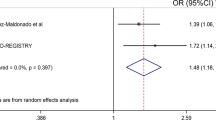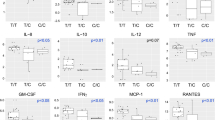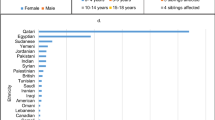Abstract
RANTES (regulated on activation, normal T-cell expressed and secreted) is a T-helper type 1 (Th1) chemokine that promotes T-cell activation and proliferation. RANTES is genetically associated with asthma, sarcoidosis and multiple sclerosis. The concentration of RANTES is increased at inflammation sites in different autoimmune diseases. Type 1 diabetes (T1D) is a Th1-mediated disease with complex genetic predisposition. We tested RANTES as a candidate gene for association with T1D using three single-nucleotide polymorphism (SNP) variants (rs4251719, rs2306630 and rs2107538) to capture haplotype information. The minor alleles of all SNPs were transmitted less frequently to T1D offspring (transmission rates 37.3% (P=0.002), 38.7% (P=0.007) and 41.0% (P=0.01)) and were less frequently present in patients compared to controls (P=0.009, 0.03 and 0.04, respectively). A similar protective effect was observed for the haplotype carrying three minor alleles (transmission disequilibrium test (TDT): P=0.003; odds ratio (OR)=0.55; confidence interval (CI): 0.37–0.83; case/control: P=0.03; OR=0.74; CI: 0.55–0.98). Both patients and controls carrying the protective haplotype express significantly lower serum levels of RANTES compared to non-carriers. Subsequently, we tested a cohort of 310 celiac disease patients, but failed to detect association. RANTES SNPs are significantly associated with RANTES serum concentration and development of T1D. The rs4251719*A–rs2306630*A–rs2107538*A haplotype associated with low RANTES production confers protection from T1D. Our data imply that RANTES is associated with T1D both genetically and functionally, and contributes to diabetes-prone Th1 cytokine profile.
This is a preview of subscription content, access via your institution
Access options
Subscribe to this journal
Receive 6 digital issues and online access to articles
$119.00 per year
only $19.83 per issue
Buy this article
- Purchase on Springer Link
- Instant access to full article PDF
Prices may be subject to local taxes which are calculated during checkout

Similar content being viewed by others
References
Atkinson MA, Eisenbarth GS . Type 1 diabetes: new perspectives on disease pathogenesis and treatment. Lancet 2001; 358: 221–229.
Ueda H, Howson JM, Esposito L, Heward J, Snook H, Chamberlain G et al. Association of the T-cell regulatory gene CTLA4 with susceptibility to autoimmune disease. Nature 2003; 423: 506–511.
Bottini N, Musumeci L, Alonso A, Rahmouni S, Nika K, Rostamkhani M et al. A functional variant of lymphoid tyrosine phosphatase is associated with type I diabetes. Nat Genet 2004; 36: 337–338.
Kelly MA, Rayner ML, Mijovic CH, Barnett AH . Molecular aspects of type 1 diabetes. Mol Pathol 2003; 56: 1–10.
Hizawa N, Yamaguchi E, Konno S, Tanino Y, Jinushi E, Nishimura M . A functional polymorphism in the RANTES gene promoter is associated with the development of late-onset asthma. Am J Respir Crit Care Med 2002; 166: 686–690.
Al-Abdulhadi SA, Helms PJ, Main M, Smith O, Christie G . Preferential transmission and association of the −403 G → A promoter RANTES polymorphism with atopic asthma. Genes Immun 2005; 6: 24–30.
Nickel RG, Casolaro V, Wahn U, Beyer K, Barnes KC, Plunkett BS et al. Atopic dermatitis is associated with a functional mutation in the promoter of the C–C chemokine RANTES. J Immunol 2000; 164: 1612–1616.
Takada T, Suzuki E, Ishida T, Moriyama H, Ooi H, Hasegawa T et al. Polymorphism in RANTES chemokine promoter affects extent of sarcoidosis in a Japanese population. Tissue Antigens 2001; 58: 293–298.
Leung TF, Tang NL, Lam CW, Li AM, Fung SL, Chan IH et al. RANTES G−401A polymorphism is associated with allergen sensitization and FEV1 in Chinese children. Respir Med 2005; 99: 216–219.
Kozma GT, Falus A, Bojszko A, Krikovszky D, Szabo T, Nagy A et al. Lack of association between atopic eczema/dermatitis syndrome and polymorphisms in the promoter region of RANTES and regulatory region of MCP-1. Allergy 2002; 57: 160–163.
Makki RF, al Sharif F, Gonzalez-Gay MA, Garcia-Porrua C, Ollier WE, Hajeer AH . RANTES gene polymorphism in polymyalgia rheumatica, giant cell arteritis and rheumatoid arthritis. Clin Exp Rheumatol 2000; 18: 391–393.
Gade-Andavolu R, Comings DE, MacMurray J, Vuthoori RK, Tourtellotte WW, Nagra RM et al. RANTES: a genetic risk marker for multiple sclerosis. Mult Scler 2004; 10: 536–539.
Luster AD . Chemokines – chemotactic cytokines that mediate inflammation. N Engl J Med 1998; 338: 436–445.
Gerard C, Rollins BJ . Chemokines and disease. Nat Immunol 2001; 2: 108–115.
Taub DD, Turcovski-Corrales SM, Key ML, Longo DL, Murphy WJ . Chemokines and T lymphocyte activation: I. Beta chemokines costimulate human T lymphocyte activation in vitro. J Immunol 1996; 156: 2095–2103.
Bacon KB, Premack BA, Gardner P, Schall TJ . Activation of dual T cell signaling pathways by the chemokine RANTES. Science 1995; 269: 1727–1730.
Wong MM, Fish EN . Chemokines: attractive mediators of the immune response. Semin Immunol 2003; 15: 5–14.
Zou W, Borvak J, Marches F, Wei S, Galanaud P, Emilie D et al. Macrophage-derived dendritic cells have strong Th1-polarizing potential mediated by beta-chemokines rather than IL-12. J Immunol 2000; 165: 4388–4396.
Frauenschuh A, DeVico AL, Lim SP, Gallo RC, Garzino-Demo A . Differential polarization of immune responses by co-administration of antigens with chemokines. Vaccine 2004; 23: 546–554.
Makino Y, Cook DN, Smithies O, Hwang OY, Neilson EG, Turka LA et al. Impaired T cell function in RANTES-deficient mice. Clin Immunol 2002; 102: 302–309.
Liu H, Chao D, Nakayama EE, Taguchi H, Goto M, Xin X et al. Polymorphism in RANTES chemokine promoter affects HIV-1 disease progression. Proc Natl Acad Sci USA 1999; 96: 4581–4585.
An P, Nelson GW, Wang L, Donfield S, Goedert JJ, Phair J et al. Modulating influence on HIV/AIDS by interacting RANTES gene variants. Proc Natl Acad Sci USA 2002; 99: 10002–10007.
The International HapMap Consortium. The International HapMap Project. Nature 2003; 426: 789–796.
Rodriguez-Frade JM, Vila-Coro AJ, Martin A, Nieto M, Sanchez-Madrid F, Proudfoot AE et al. Similarities and differences in RANTES- and (AOP)-RANTES-triggered signals: implications for chemotaxis. J Cell Biol 1999; 144: 755–765.
Wong M, Uddin S, Majchrzak B, Huynh T, Proudfoot AE, Platanias LC et al. Rantes activates Jak2 and Jak3 to regulate engagement of multiple signaling pathways in T cells. J Biol Chem 2001; 276: 11427–11431.
Cetkovic-Cvrlje M, Dragt AL, Vassilev A, Liu XP, Uckun FM . Targeting JAK3 with JANEX-1 for prevention of autoimmune type 1 diabetes in NOD mice. Clin Immunol 2003; 106: 213–225.
Kondoh K, Torii S, Nishida E . Control of MAP kinase signaling to the nucleus. Chromosoma 2005; 114 (2): 86–91.
Brill A, Hershkoviz R, Vaday GG, Chowers Y, Lider O . Augmentation of RANTES-induced extracellular signal-regulated kinase mediated signaling and T cell adhesion by elastase-treated fibronectin. J Immunol 2001; 166: 7121–7127.
Ando H, Kurita S, Takamura T . The specific p38 mitogen-activated protein kinase pathway inhibitor FR167653 keeps insulitis benign in nonobese diabetic mice. Life Sci 2004; 74: 1817–1827.
Eriksson C, Eneslatt K, Ivanoff J, Rantapaa-Dahlqvist S, Sundqvist KG . Abnormal expression of chemokine receptors on T-cells from patients with systemic lupus erythematosus. Lupus 2003; 12: 766–774.
Pierer M, Rethage J, Seibl R, Lauener R, Brentano F, Wagner U et al. Chemokine secretion of rheumatoid arthritis synovial fibroblasts stimulated by Toll-like receptor 2 ligands. J Immunol 2004; 172: 1256–1265.
Oki M, Ohtani H, Kinouchi Y, Sato E, Nakamura S, Matsumoto T et al. Accumulation of CCR5+ T cells around RANTES+ granulomas in Crohn's disease: a pivotal site of Th1-shifted immune response? Lab Invest 2005; 85: 137–145.
Yang B, Houlberg K, Millward A, Demaine A . Polymorphisms of chemokine and chemokine receptor genes in Type 1 diabetes mellitus and its complications. Cytokine 2004; 26: 114–121.
Buhler MM, Craig M, Donaghue KC, Badhwar P, Willis J, Manolios N et al. CCR5 genotyping in an Australian and New Zealand type 1 diabetes cohort. Autoimmunity 2002; 35: 457–461.
Masuko-Hongo K, Sato T, Nishioka K . Chemokines differentially induce matrix metalloproteinase-3 and prostaglandin E2 in human articular chondrocytes. Clin Exp Rheumatol 2005; 23: 57–62.
Locati M, Deuschle U, Massardi ML, Martinez FO, Sironi M, Sozzani S et al. Analysis of the gene expression profile activated by the CC chemokine ligand 5/RANTES and by lipopolysaccharide in human monocytes. J Immunol 2002; 168: 3557–3562.
Garcia-Vicuna R, Gomez-Gaviro MV, Dominguez-Luis MJ, Pec MK, Gonzalez-Alvaro I, Alvaro-Gracia JM et al. CC and CXC chemokine receptors mediate migration, proliferation, and matrix metalloproteinase production by fibroblast-like synoviocytes from rheumatoid arthritis patients. Arthritis Rheum 2004; 50: 3866–3877.
Schipper RF, Koeleman BP, Bruining GJ, Schreuder GM, Verduijn W, De Vries RR et al. HLA class II associations with type 1 diabetes mellitus: a multivariate approach. Tissue Antigens 2001; 57: 144–150.
Hanifi-Moghaddam P, Schloot NC, Kappler S, Seissler J, Kolb H . An association of autoantibody status and serum cytokine levels in type 1 diabetes. Diabetes 2003; 52: 1137–1142.
Revised Criteria for Diagnosis of Coeliac Disease. Report of working group of European Society of Paediatric Gastroenterology and Nutrition. Arch Dis Child 1990; 65: 909–911.
Altshuler D, Brooks LD, Chakravarti A, Collins FS, Daly MJ, Donnelly P . A haplotype map of the human genome. Nature 2005; 437: 1299–1320.
Barrett JC, Fry B, Maller J, Daly MJ . Haploview: analysis and visualization of LD and haplotype maps. Bioinformatics 2005; 21: 263–265.
Dudbridge F . Pedigree disequilibrium tests for multilocus haplotypes. Genet Epidemiol 2003; 25: 115–121.
Haldane JB . The estimation and significance of the logarithm of a ratio of frequencies. Ann Hum Genet 1956; 20: 309–311.
Acknowledgements
We are grateful to all the patients and their families and physicians for participating in the study. We thank Jackie Senior for improving the manuscript. The study was supported by grants from the Dutch Diabetes Research Foundation (97.137), The Dutch Digestive Disease Foundation (WS 03-06), The Netherlands Organization for Health Research and Development (ZonMW 912-02-028), The Juvenile Diabetes Research Foundation International (JDRF) (2001.10.004) and the Celiac Disease Consortium, an Innovative Cluster approved by the Netherlands Genomics Initiative and partially funded by the Dutch Government (BSIK03009).
Author information
Authors and Affiliations
Corresponding author
Additional information
Supplementary Information accompanies the paper on Genes and Immunity website (http://www.nature.com/gene)
Supplementary information
Rights and permissions
About this article
Cite this article
Zhernakova, A., Alizadeh, B., Eerligh, P. et al. Genetic variants of RANTES are associated with serum RANTES level and protection for type 1 diabetes. Genes Immun 7, 544–549 (2006). https://doi.org/10.1038/sj.gene.6364326
Received:
Revised:
Accepted:
Published:
Issue Date:
DOI: https://doi.org/10.1038/sj.gene.6364326
Keywords
This article is cited by
-
GWAS for autoimmune Addison’s disease identifies multiple risk loci and highlights AIRE in disease susceptibility
Nature Communications (2021)
-
Bisphenol A alteration of type 1 diabetes in non-obese diabetic (NOD) female mice is dependent on window of exposure
Archives of Toxicology (2019)
-
Chemokine Ligand 5 (CCL5) and chemokine receptor (CCR5) genetic variants and prostate cancer risk among men of African Descent:a case-control study
Hereditary Cancer in Clinical Practice (2012)
-
Congenital toxoplasmosis: candidate host immune genes relevant for vertical transmission and pathogenesis
Genes & Immunity (2010)
-
Sequential Changes in Serum Cytokines Reflect Viral RNA Kinetics in Target Organs of a Coxsackievirus B Infection in Mice
Journal of Clinical Immunology (2009)



